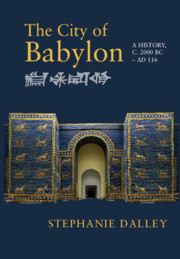Book contents
- The City of Babylon
- The City of Babylon
- Copyright page
- Contents
- Illustrations and Maps
- Preface
- Conventions
- Timeline
- Written Languages and Their Scripts
- 1 Land and Peoples
- 2 Discoveries and Excavations
- 3 First Kings to the End of the Great Rebellion, c. 1894–c. 1732
- 4 Law, Education, Literature, and the Path to Supremacy
- 5 From the Great Rebellion to the End of the First Dynasty, c. 1732–1592
- 6 The Next Six Centuries
- 7 In the Shadow of Assyria, 978–625
- 8 Empire
- 9 From the Death of Nebuchadnezzar II to the Death of Cambyses, 561–522
- 10 Darius I to Alexander, and Seleucid to Parthian Rule
- 11 First Parthian Conquest, 141 BC, to the Visit of Trajan in AD 116
- Appendix: Genesis 14:1–16 and Possible Links with Foreign Rulers Early in the Reign of Hammurabi
- Bibliography
- Index
2 - Discoveries and Excavations
Published online by Cambridge University Press: 23 June 2021
- The City of Babylon
- The City of Babylon
- Copyright page
- Contents
- Illustrations and Maps
- Preface
- Conventions
- Timeline
- Written Languages and Their Scripts
- 1 Land and Peoples
- 2 Discoveries and Excavations
- 3 First Kings to the End of the Great Rebellion, c. 1894–c. 1732
- 4 Law, Education, Literature, and the Path to Supremacy
- 5 From the Great Rebellion to the End of the First Dynasty, c. 1732–1592
- 6 The Next Six Centuries
- 7 In the Shadow of Assyria, 978–625
- 8 Empire
- 9 From the Death of Nebuchadnezzar II to the Death of Cambyses, 561–522
- 10 Darius I to Alexander, and Seleucid to Parthian Rule
- 11 First Parthian Conquest, 141 BC, to the Visit of Trajan in AD 116
- Appendix: Genesis 14:1–16 and Possible Links with Foreign Rulers Early in the Reign of Hammurabi
- Bibliography
- Index
Summary
Early explorers and excavators knew only biblical and classical accounts, some of them garbled and confusing. They were unaware that Babylon had an advanced literate culture. Mud-brick ruins contrasted unfavourably with marble, and the sprawling site of Babylon had many separate mounds, with the Tower of Babel indistinguishable amid the rubble. As Babylon’s power grew, quarters of the citadel were named after more ancient cities, and branches of temples to deities in other cities became established there. Early travellers from the twelfth century onwards brought back to the west their accounts of what they saw. In the seventeenth century, cuneiform writing on stone was identified at Persepolis. In the seventeenth to nineteenth centuries, cuneiform inscriptions from Mesopotamia increasingly arrived in Europe and a few national museums were soon built to house the items discovered by travellers, dilettante collectors, and informal excavators. Decipherment then began to excite public interest, but literal understanding gave way only slowly to appreciation of symbolism and rhetoric. Official excavations in Babylon took place under German leadership between 1899 and 1917. A chronological sequence for the history still has a few unsolved problems. Cuneiform writing unexpectedly lasted into Roman times.
Keywords
- Type
- Chapter
- Information
- The City of BabylonA History, c. 2000 BC – AD 116, pp. 22 - 47Publisher: Cambridge University PressPrint publication year: 2021

